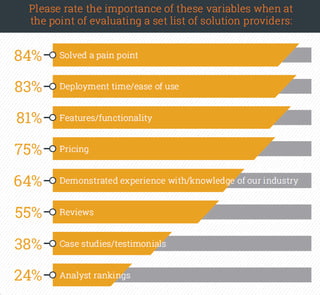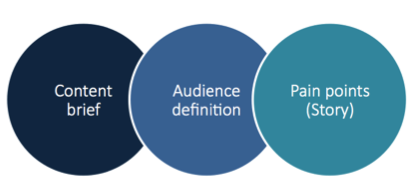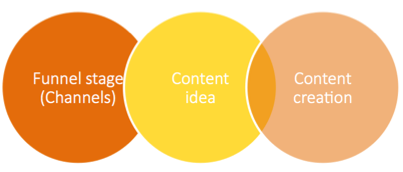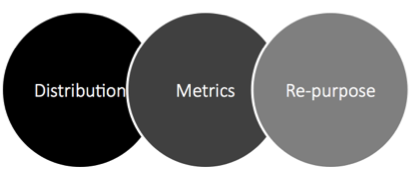7x ways to stay on top of your marketing game in today’s non-stop digital market place.

What can businesses do to stay on top of their game and develop a long-term plan for growth?
There’s no simple answer to this question: from the quality of your business’s products to it’s management style or business environment, there are many variables that can affect performance.
What we can say however, is that the way in which you communicate and engage with your target audience does have a major impact. Today we operate in a relationship economy, where buyers look to build rapport and a level of trust in the companies that they deal with.
So how can a marketer go about building and maintaining a strong relationship with a B2B prospective buyer – focusing on why your business does what it does, how it does it and what it does?
The reality is that a B2B sales prospect will find you when they’re ready to buy something; no matter how much effort you put into chasing them.
The cost of customer acquisition can depend on if it is an existing customer or a potential new one, as it costs far less to retain existing customers. According to Marketing Metrics, the probability of selling to a new prospective customer is 5%-20% whereas the probability of selling to an existing customer is 60%–70%.
But if a business fails to get in front of their target audience at the moment that they are considering their options, it can mean less leads to fill the sales pipeline and a decline in sales.
Traditionally outbound marketing was the go to tactic to generate leads and make noise in the market, with businesses pushing out information to contacts whether they asked for it or not.
1) Outbound Can Mean Interruption Marketing
Once upon a time, marketers approached customers with a one-size-fits-all message not necessarily at the right time or matching their needs.
By pushing a “one way” message its difficult be sure where your prospect is in their buying cycle. Are they just starting to look, do they even know they have a problem or are they already far along the sales cycle and you are adding no value to the conversation?
Today prospective buyers expect much more. Access to social media means they have the ability to post opinions when companies get their message or timing wrong, which can have a direct impact on your brand’s reputation.
But there is often a gap between how sellers communicate and how buyers wish to source and digest content, the information that you as a company create to explain what you do – the content marketing.
Typically sellers had historically relied on outbound tactics to get their sales messages across, whereas B2B buyers today are now doing far more online self-research to educate themselves. Either filtering out what you have to say at the expense of missing a sale or shifting to a vendor that takes a more educational rather than selling approach to their needs.
B2B buyers are in an especially strong position now, there are far more vendor options available, the cost of switching between vendors is not so cost prohibitive and they have the power to dictate terms. By using the internet they are able to travel further long the buying journey only making contact when they are ready, have all the relevant details to hand and know the deal that they want to negotiate.
If you think of many of the sales tactics employed in the market today they probably fall into the following categories; email, direct mail, conferences, trade shows, cold calling, on-line banner / display ads, etc. And from a marketing perspective it would be print ads, billboards and outdoor advertising, TV & Radio, display ads, brochures, etc. With so many messages thrust into our daily lives, it’s no wonder that buyers may be filtering out your message.
When you compare the outbound tactics versus the buyer interaction preferences you can see that there is a risk of a mis-match.
Looking at the research from Demand Gen B2B Buyers Survey Report 2016 the most important factor in evaluating a B2B vendor is that they show evidence of being able to solve a pain point (see chart below).

To be in a position to know what that particular pain point is, you need to have researched your buyer, created a buyer persona profile to know what their pain is. This is an approach that cannot be done effectively using an outbound strategy because it becomes a numbers game, using an expensive marketing model with multiple messages and complexities where you hope if you send out enough communications at some point it will hit a target.
2) Segmenting Your Email Efforts
Segmentation has been popular in the past when it was seen as an innovative way to boost conversion by ensuring at least some of the content being sent to subscribers was relevant.
Relevancy is becoming even more central to today’s digital marketing strategy, according to a study by MarketingSherpa, four out of ten subscribers reported that they’ve marked emails as spam simply because they found their content irrelevant.
A core business goal is typically to attract website visitors and convert them into sales leads by gathering email addresses and other relevant business information. As a business your responsibility is to then share valuable, timely and relevant content to guide these leads through their buying process until they are ready to buy from you.
So what does a good segmentation strategy look like?
There are a number of different ways to start segmenting your email audience. For a segmentation method to work, however, it needs to reflect two things: Your core business strategy and What you know about your typical buyers’ purchasing decisions.
Segmentation allows marketers to execute lifecycle marketing. These segments, also known as lists, can be cut and combined in a number of different ways — industry, demographic information, company size, job role, etc. Who somebody is (Buyer Persona), and where they are on their buyers journey are two of the most important segmentation strategies.
Inbound marketing is all about getting leads to come to you, “attract or pull” marketing, focusing just as much on the context of your message as the content you deliver.
You can create an email masterpiece, but if it doesn’t resonate with your subscribers in terms of timeliness or address their “pain or gain” points then it will be a lost cause, wasting time and money.
Some of the pitfalls to avoid in communicating with your subscribers are:
- Not having clean data makes for inaccurate segmentation.
- Defining a segment with an assumption is a risk.
- Analyse the performance of your data based on the right goal setting.
- You’ve based your ideal profile on a small amount of data you got once and have never updated.
- Not all your customers want to interact with your company in the same way.
- Timing is critical – how long is the sales cycle?
- Taking time to compare performances.
- Making observations on your results and following-up.
3) Marketing Automation To Improve Your Impact
A successful marketing automation programme triggers sales and marketing activities based on customer interactions set off by opening your emails, reading your blogs posts, visiting your website, and engaging with your business across social media.
In recent years,“marketing automation” has become an industry buzzword. It refers to the software that exists with the goal of automating repetitive marketing tasks.
Marketing automation enables your business to:
- Receive more and better quality leads for nurturing
- Improve on overall marketing productivity
- Work on improving conversion rates
Over the last couple of years marketing automation has grown beyond an email platform used solely for customer acquisition and become more integrated into customer lifecycle marketing. Working on lead management from acquisition and engagement to retention and conversion.
“On average 49% of companies are currently using Marketing automation. With more than half of B2B companies (55%) adopting the technology.” – Emailmonday – The Ultimate Marketing Automation stats. (2016)
As the marketing environment continues to fragment and make it difficult to consistently reach your target audience, an effective marketing automation strategy can help align your sales and marketing efforts. By combining emails with other marketing channels there is an opportunity to grow awareness, improve engagement and customer acquisition as per the chart below from Salesforce.com.
Starting with Strategy, developing Lead generation programmes, Optimising for the best fit and then working hard towards a strong ROI (see chart below) is how we use Marketing automation to help companies grow.

4) Is Your Sales Funnel Effective?
Typically a prospect or visitor to your website won’t buy from you at first glance, it takes time to establish trust and assess your level of authority.
The sales funnel lays out the various stages (depending on your type of business) that are passed through as a relationship evolves between the buyer and the seller.
The idea of the funnel is that the number of leads grows smaller as you persuade them to move down the funnel. At the top of the funnel (TOFU), there are many people who you will want to make aware of your brand. The middle of the funnel (MOFU) is smaller, as there are less people who would actually consider you as an option, and at the bottom of the funnel (BOFU) it is narrowest as the number of people who are in a position to buy from you becomes smaller.
To avoid prematurely presenting a solution to a buyer it can be helpful to assess your approach against the following questions:
- Do you have a Customer Lifecycle definition (suspects, prospects, leads, contacted, converted, lapsed or lost)?
- What is your industry, are there particular buying patterns, preferred contact channels, decision maker profiles?
- Do you communicate differently as customers go through the various stages in the funnel?
- Do you know how to qualify a lead, and when to pass it on to the sales team?
As a visitor moves along the funnel, the content used to address the questions and nurture engaged prospects will be different at each stage.
The chart below shows the buying journey (from Awareness to Decision) that your B2B sales prospects theoretically take as they go from realising that they have a problem right through to shortlisting vendors and making a purchase.
A funnel visualises the journey and helps you apply your marketing and sales efforts accordingly. For example, don’t talk about product features at the beginning of your relationship when visitors aren’t familiar with your brand or products or don’t realise that they actually have a need.
The funnel traditionally has been a linear process where visitors start at the top of the funnel and then make their way down to the end – to buy or not buy. If you don’t buy, you must be either stuck in the middle or fallen out of the bottom. In the context of sales, just because your customer has reached the end of the funnel it does not mean the end of a customer’s journey.
The sales funnel today needs to recognise that prospective buyers leave and jump into the funnel at different stages – a “leaky funnel” not necessarily always in the same place.
But one thing that is clear is that no matter where your prospects are in the funnel, they are looking to educate themselves. Think about the signals you receive that show the intentions of your sales prospects and how you can aid their search for information to help them carry on with their journey.
5) Improving Your Customer Experience
To get a positive return on your sales and marketing efforts, you’ll need to offer value and a great customer experience (CX) all the way along the buying journey. Being able to offer advice and value to prospects regardless of whether they’re ready to buy, builds credibility and authority.
The path to purchase, from start to finish, is rarely linear— it’s more like a game of “snakes & ladders”. To build credibility with your prospects offer free advice regardless of whether they are ready to buy.
Mapping The Customer Journey
In terms of distribution you may be able to sell your product or services in many different places. However, it is important to understand how visitors find you, and the journey that takes them from the first touch point through to becoming a customer.
Mapping enables you to see all the interactions and facilitates a common understanding of the customers points of friction along the path to purchase.
Questions to consider in planning a customer journey mapping are:
- Where do you have most interaction with customers?
- Is there a particular order to your customer’s journey?
- Any particular touch point that you could influence?
- Do you know where customers are accessing essential buying information on your products and services?
The idea of ‘understanding a customer journey’ is being able to track and visualise how individuals engage and interact with your business across multiple channels, and to decide where to focus your efforts to influence buyers.
A customer journey map needs to take into account both the emotional and rational thoughts that go into a purchase. The mapping should identify the gaps, how you are missing opportunities, falling short on service, etc.
It is then time to address why you are failing and how to improve your approach to raise customer experience before, during and post-sale.
6) Educate, Don’t Sell – Inbound Sales
“Selling to people who actually want to hear from you is more effective than interrupting strangers who don’t. Seth Godin
Whereas some businesses may still be in the habit of viewing their prospects as numbers in the sales funnel, the newly empowered buyer can see through this, especially in the transparent digital economy we experience today.
By shifting your focus and impressing upon buyers the desire to offer advice first and foremost it can help open up the opportunity for constructive dialogue.
In general, buyers do not have available all the details they may need to make a complex purchase, especially something that falls outside their own area of expertise. So there will always be a need to have direct sales contact especially for those buyers involved in a long and complicated sales process such as purchasing technology.
One of the most important lessons from an Inbound perspective is to learn how to sell in the way your customers want to buy.
Teach buyers through your communications:
- How to recognise that they have a problem
- Help them understand the benefits of addressing those needs
- Show them that your offering may be a possible solution
Helping is the new selling. The most successful salespeople are the ones who aren’t viewed as salespeople, but who are subject matter experts and add value through advice and sharing knowledge.
Pursuing a prospect prematurely along the sales process will typically end in a missed opportunity, as the buyer may not be ready or just not a good fit for your business. Before you can identify those potential buyers, you need to define the ideal buyer profile which defines those buyers who are a good fit for your offering or not.
By building a fuller, personalised picture of the customer and their journey, you will become more informed of the motivations behind buying decisions, generating insights on who your buyers are and be able to predict their digital behaviour.
So instead of focusing on your own needs to close a sale, focus instead on the buyer’s desire to get a problem solved. So talk about the problem. Start conversations around the buyer’s plans, goals and challenges. Lead with a message targeted to the buyer’s context, what is their pain, what options do they have, what are the consequences if they fail?
7) Content Creation – The Why, Who And What?
So How Do You Create Content?
To get the production, distribution and analysis of your content flowing it is a good idea to build a robust content process.

A good starting point is to look at creating a clear and concise content brief, documenting budgets to themes to methods and goals. At the same time you will need to define the target audience, and the main story telling points that reflect the pain of your target audience which you will use as keywords, titles and content drivers.
It can help fine tune your message if you have as a part of the process a Content Mission statement. For example:
- WHY you’re creating content
- WHO you’re creating content for
- WHAT you’re delivering to your audience and how it will benefit them

Once you have the brief, audience defined and the pain points identified, it is time to work on the content that will resonate with your target audience. Now it is time to get creative, brainstorm some ideas and get into ideation mode. Don’t forget to look back at content you have already produced to see how it performed, identify sales triggers and remember to be creative in terms of using media that will be on the radar of your audience.

Now you will need to distribute your content. Use your buyer persona insights to target where your audience searches for information, the format that they enjoy and the level of interaction they would prefer.
Soon you will need to assess the impact of your content, look at the metrics and review whether there is a need to make any amendments to improve it’s reach and impact.
Content distribution can be considered as a way to extend the reach of your content marketing, it’s all about making sure the content you create gets found, read and shared by the right audience. A “rule of thumb” is to spend 50% of your efforts on creating the content and the other 50% on distribution efforts.
Take Away
So what can a business do to stay on top of their game and develop a long-term plan for growth? Well we have given you seven points to think about your own approach for a winning “game plan” and when GDPR comes in May 2018, it’s going to get even harder to get through to your target audience.
So use the time now to prepare your content, know your audience and how they like to interact and take a moment to walk in your customers shoes to see if the experience of being a customer of yours is as positive as you think.

